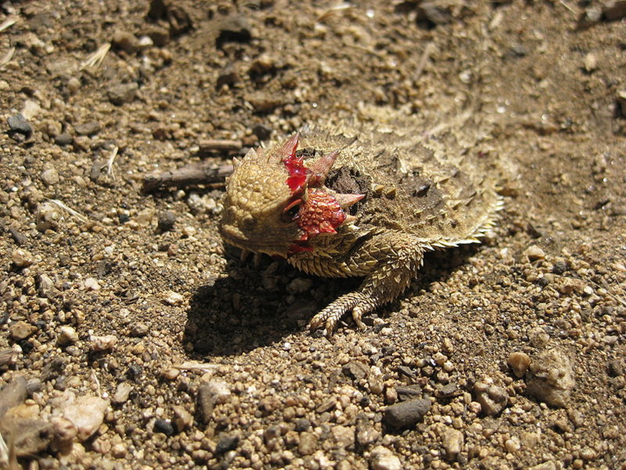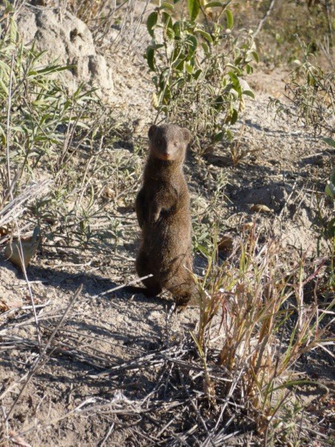« Prev Next »

Most animals face the risk of being eaten. It's hard to pass on your genes when you're dead; therefore, the threat of predation imposes strong selective pressure on organisms, resulting in a myriad of behavioral strategies that allow them to survive. To avoid becoming someone's dinner, an organism must be able to identify predatory threats and employ effective strategies to avoid detection by predators. In the event that avoidance fails, animals can use behaviors designed to prevent predators from attacking, and have tactics that will increase their chances of surviving attack if it does occur.
Detecting predators
In order to effectively avoid and respond to predation, animals must first identify the presence of a potential predator. The ability to recognize predator cues is essential for the initiation of antipredator behavior. This can be innate, for example, animals can identify predators as a threat even if they have never encountered them before, or learned only after exposure to a predatory threat. Some captive breeding programs expose animals to predatory cues in captivity to teach them to respond to these predators after release in the field, increasing their survival rates. Animals can respond to general cues of the presence of a predatory threat, such as sudden movement or the presence of a looming object, or to species-specific cues, such as scent or appearance, which allows them to distinguish between predatory and non-predatory species. Many species rely on the presence of multiple cues to accurately assess the level of threat. These can have additive effects, with animals being more likely to respond if a greater number of cues are detected, as this provides a more reliable indication of a predator's presence and identity.
Prey can rely on a variety of sensory modes to detect these predator cues, including visual, chemical, auditory, and tactile senses.
a. Visual — As mentioned above, many animals respond to generic visual cues, such as the presence of a novel object or sudden movement. Other visual cues, including an animal's size and behavior, can provide specific information about the identity and intention of a potential predator. For example, prey may be able to visually identify a predator based on its shape, size, and color, and can use the predator's behavior to determine the immediate threat that it poses. A predator that is feeding or courting, for example, would pose less of a threat than a predator that is approaching and looking directly at its prey. Visual cues may be less informative in habitats with low visibility or when faced with cryptic predators. In these situations, prey may rely on other cues of predator presence.
b. Chemical — Much like with visual cues, animals can detect the presence of predators through both general and species-specific chemical signals. For example, chemical cues from recently killed conspecifics may provide general information about the presence of predatory threat, whereas chemicals in urine and skin lipids may be used to determine the identity of potential predators. Chemosensory (chemical) cues can be present in the air, in water, or on the ground, and can be detected by prey through olfaction and gustation, providing a reliable indication of a predator's presence even if it is visually undetectable. Some species are even able to determine how old a predator scent is, and will avoid only fresh scent cues as they indicate a predator's recent presence. Animals can also use changes in the concentration or age of a scent to determine which direction a predator was traveling, in order to better avoid it.
c. Auditory — Auditory cues can provide reliable, direct information about a predator's presence, identity, proximity, and even direction of travel. These cues are especially helpful for nocturnal prey species or animals that avoid predators that frequently use sound to hunt or communicate. For example, toadfish (family Batrachoididae) recognize the foraging vocalizations of dolphins, one of their main predators, and reduce their activity levels in response.
d. Tactile — Vibrational cues can provide useful information about a predator's presence, and can be difficult for predators to conceal. Many animals, including some spiders, caterpillars, and tadpoles, use substrate-borne vibrations as indicators of predator presence, and can distinguish vibrations made by predators, non-predators, and abiotic cues (such as rainfall). Antarctic limpets (Nacella concinna) respond to physical contact with predatory sea stars (Neosmilaster georgianus) by raising their shells and fleeing, but tactile cues from a less threatening omnivorous starfish do not elicit this response. It is important for prey to be able to distinguish cues from threats versus non-threats, as responding to every tactile stimulus would waste time and energy, and may actually attract the attention of predators.
Avoiding Predators
After an animal has determined that a predator is nearby, it must then take action to avoid encountering this threat. Encounters are most easily avoided by preventing predators from detecting prey in the first instance. One effective strategy by which animals can accomplish this is by spatially or temporally avoiding predators. This can be achieved by avoiding habitat occupied by predators, being active at different times of the day to a predator, or altering activity in response to changes in risk. Anolis lizards (Anolis sagrei) become more arboreal following the introduction of a ground-dwelling predator, and Merriam's kangaroo rats (Dipodomys merriami) shift from nocturnal to crepuscular foraging during full moon, when they are more vulnerable to predation. Just as prey use cues to detect the presence of predators, predators use cues to detect prey. Animals can therefore avoid attracting a predator's attention by minimizing cues of their presence, such as by remaining silent, seeking refuge, and reducing overall activity levels when risk of predation is high.
The term camouflage usually conjures up images of physical characteristics such as coloration; however, animals can also use behavior to disguise themselves and avoid detection by predators. Cephalopods and some reptiles can change color hue and pattern of their skin, and even its texture, to blend into their background (Video 1). Alternatively, some animals, such as decorator crabs, can attach external objects including plant matter or stones, to their bodies to allow them to better match their background. Behavioral postures and movement can also allow animals to disguise themselves; chameleons and walking stick insects mimic the motion of plants in the wind to avoid detection, and the mimic octopus takes on the shape of dangerous or unpalatable animals to deter predators. Animals can also camouflage their scent cues. Squirrels do this by chewing up shed rattlesnake skin and spread it on their fur, thereby masking their scent and identity as potential prey.
Surviving Encounters with Predators
If an animal is detected by a predator, there are several strategies that can improve its chances of surviving the encounter. These generally function to deter an attack through intimidation, flight, deception, and fighting back. Prey that live in large groups can intimidate a predator by simultaneously mobbing it, driving it away before it can attack. Prey can also use behavior to signal to a predator that it would be a waste of time and energy attempting an attack. For example, pushups performed by lizards and stotting in gazelles act as signals of physical fitness and likelihood of escaping attack. These are honest signals, as they are energetically demanding and only physically fit animals can perform these vigorous displays.
A prey that is approached by a predator may flee to escape. This tactic is useful if the predator is not too close and/or there is a refuge nearby, and the chance of the prey escaping is high. If a predator is too close or an animal is unlikely to be able to escape by fleeing, it can attempt to deter the impending attack. Some animals, including opossums and some reptiles, feign death (letisimulation) to discourage attack, since many predators are not interested in carrion. Other animals use the prey-finding mechanisms of their predators against them; some moths identify echolocations of attacking bats and produce a split-second, nose-dive response to these cues to flee, while others have evolved the ability to make loud noises that jam this ecolocation ability, allowing them to avoid capture. Threatened animals may also sacrifice nonessential body parts to distract the predator and permit them to escape. Such tactics include autotomy of tails or limbs by some reptiles, insects and sea stars, and ejection of internal organs by sea cucumbers. Exuding foul tasting or toxic compounds can also encourage release by a predator that has already attacked. The regal horned lizard shoots blood from its eyes which acts as an irritant, deterring canine predators (Figure 1).

Although effective, these strategies are energetically expensive with potentially long recovery times to regenerate body parts or toxins, during which time an animal is more vulnerable to subsequent attacks. Less costly strategies include behavior that makes animals too big or unwieldy to eat, for example, inflating their bodies or biting their own tails to form an unmanageable ring, as with armadillo lizards. Biting, charging, and scratching are other effective forms of defense that work by chasing potential predators away or encouraging them to release the prey after capture (Video 2).
Choosing the Best Strategy
Although antipredator behavior carries the important benefit of increasing an animal’s chances of avoiding predation, it can incur significant costs. Time spent hiding or being vigilant (scanning for predators) limits the amount of time animals have available for other important activities, such as foraging or searching for mates. Some social species reduce these costs by taking it in turns to look out for predators. The common dwarf mongoose post sentries that stand upright on their hindlimbs to watch for avian predators, and alert conspecifics of impending danger (Figure 2). Individuals act as sentries only when they have recently fed to avoid costs of lost foraging time.

The costs associated with antipredator behavior have driven the ability of animals to distinguish the level of threat imposed by different potential predators, and therefore respond only when necessary. Some animals, including herd ungulates and schooling fish species, will approach or investigate the predator to assess the level of threat it poses. After quickly approaching the predator to gather information, the animal will then either rejoin the herd, flee, or even attack the predator, depending upon the information it gains about the predator’s identity and intent. The ability to respond only to specific predators can be beneficial, as an individual’s behavior can be tailored accordingly, but can prove problematic in the presence of novel predators such as invasive species. Native animals may not recognize these new species as a threat and fail to produce the appropriate anti-predator behavior; these naïve individuals may suffer high levels of mortality. Eastern fence lizards provide an example of this, as native lizards fail to recognize and respond to invasive fire ant predators until they have co-occurred with them for several generations (Video 3).
Summary
Glossary
Conspecifics — individuals of the same species
Olfaction — sense of smell
Gustation — sense of taste
Crepuscular — active at dawn and dusk
Mobbing — crowding or attacking as a group
Stotting — a springing or bouncing gait used by herd animals when chased by predators
Honest signals — signals that cannot be deceptively produced and therefore provide reliable information about an individual’s quality
Autotomy — self-amputation of an appendage, such as a tail
Sentries — animals stationed to watch for potential dangers
Fitness — production of reproductively viable offspring
References and Recommended Reading
Hawkins, L. A., Magurran, A. E., & J. D. Armstrong. Ontogenetic learning of predator recognition in hatchery-reared Atlantic salmon, Salmo salar. Animal Behaviour 75, 1663–1671 (2008).
Amo, L. P. López, & J. Martín. Wall lizards combine chemical and visual cues of ambush snake predators to avoid overestimating risk inside refuges. Animal Behaviour 67, 647–653 (2004).
Brown, G. E. & J. G. Godin. Who dares, learns: chemical inspection behaviour and acquired predator recognition in a characin fish. Animal Behaviour 57, 475–481 (1999).
Remage-Healey, L., Nowacek, D. P., & A. H. Bass. Dolphin foraging sounds depress calling and elevate stress hormone levels in a prey species, the Gulf toadfish. Journal of Experimental Biology 209, 4444–51 (2006).
Warkentin, K. M. How do embryos assess risk? Vibrational cues in predator-induced hatching of red-eyed treefrogs. Animal Behaviour 70, 59–71 (2005).
Mahon, A., Amsler, C., McLintock, J. B. & B. J. Baker. Chemo-tactile predator avoidance responses of the common Antarctic limpet, Nacella concinna. Polar Biology 25, 469–473 (2002).
Schoener, T. W., Spiller, D. A., & J. B. Losos. Predation on a common Anolis lizard: can the food web effects of a devastating predator be reversed? Ecological Monographs 72, 383–407 (2002).
Daly, M., Behrends, P. R., Wilson, M. I. & L. F. Jacobs. Behavioural modulation of predation risk: moonlight avoidance and crepuscular compensation in a nocturnal desert rodent, Dipodomys merriami. Animal Behaviour 44, 1–9 (1992).
Stuart-Fox, D., Moussalli, A. & M. J. Whiting. Predator-specific camouflage in chameleons. Biology Letters 4, 326–329 (2008).
Stachowicz, J. J., & M.E. Hay. Geographic variation in camouflage specialization by a decorator crab. American Naturalist 156, 59–71 (2000).
Norman, M. D., Finn, J., & T. Tregenza. Dynamic mimicry in an Indo-Malayan octopus. Proceedings of the Royal Society of London B 268, 1755–1758 (2001).
Clucas, B., Owings, D. H. & Rowe, M. P. Donning your enemy’s cloak: ground dquirrels exploit rattlesnake scent to reduce predation risk. Proceedings of the Royal Society B 275, 847–852 (2008).
Leal, M. Honest signalling during prey-predator interactions in the lizard Anolis cristatellus. Animal Behaviour 58, 521–526 (1999).
FitzGibbon, C. D. & Fanshawe, J. H. Stotting in Thomson’s gazelles: an honest signal of condition. Behavioral Ecology and Sociobiology 23, 69–74 (1988).
Corcoran, A. J., Barber, J. R. & W. E. Conner. Tiger moth jams bat sonar. Science 325, 325–327 (2009).
Middendorf, G. A. & W. C. Sherbrooke. Canid elicitation of blood-squirting in a horned lizard (Phrynosoma cornutum). Copeia 2, 519–527 (1992).
Sih, A. Prey uncertainty and the balancing of antipredator and feeding needs. The American Naturalist 139, 1052–1069 (1992).
Clutton-Brock, T. H. et al. Selfish sentinels in cooperative mammals. Science 284, 1640–1644 (1999).
Langkilde, T. Invasive fire ants alter behavior and morphology of native lizards. Ecology 90, 208–217 (2009).






























